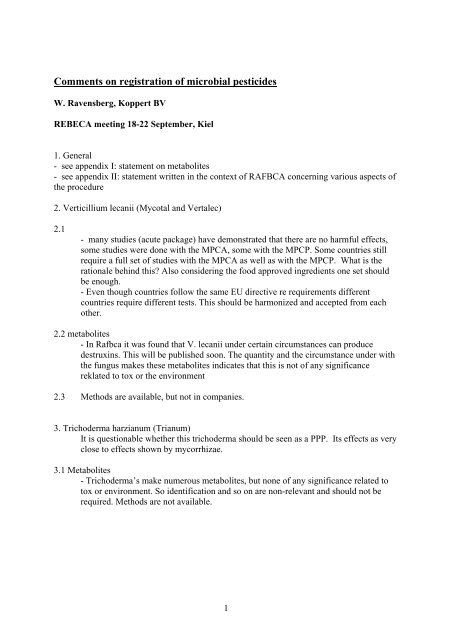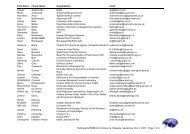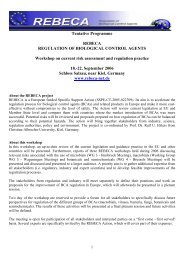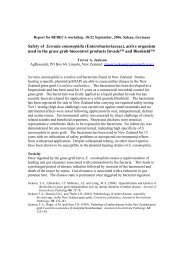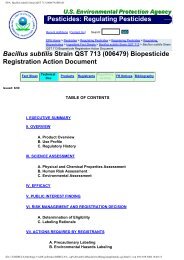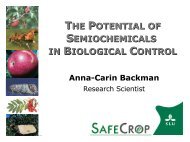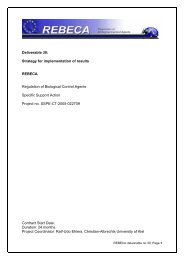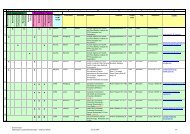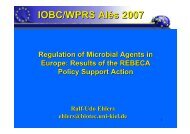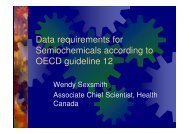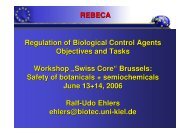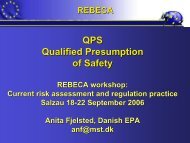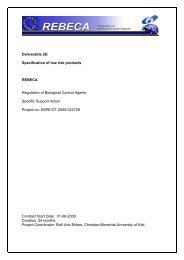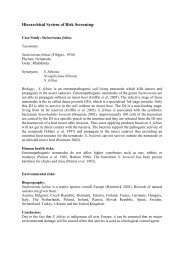(Verticillium) lecanii - REBECA
(Verticillium) lecanii - REBECA
(Verticillium) lecanii - REBECA
Create successful ePaper yourself
Turn your PDF publications into a flip-book with our unique Google optimized e-Paper software.
Comments on registration of microbial pesticides<br />
W. Ravensberg, Koppert BV<br />
<strong>REBECA</strong> meeting 18-22 September, Kiel<br />
1. General<br />
- see appendix I: statement on metabolites<br />
- see appendix II: statement written in the context of RAFBCA concerning various aspects of<br />
the procedure<br />
2. <strong>Verticillium</strong> <strong>lecanii</strong> (Mycotal and Vertalec)<br />
2.1<br />
- many studies (acute package) have demonstrated that there are no harmful effects,<br />
some studies were done with the MPCA, some with the MPCP. Some countries still<br />
require a full set of studies with the MPCA as well as with the MPCP. What is the<br />
rationale behind this? Also considering the food approved ingredients one set should<br />
be enough.<br />
- Even though countries follow the same EU directive re requirements different<br />
countries require different tests. This should be harmonized and accepted from each<br />
other.<br />
2.2 metabolites<br />
- In Rafbca it was found that V. <strong>lecanii</strong> under certain circumstances can produce<br />
destruxins. This will be published soon. The quantity and the circumstance under with<br />
the fungus makes these metabolites indicates that this is not of any significance<br />
reklated to tox or the environment<br />
2.3 Methods are available, but not in companies.<br />
3. Trichoderma harzianum (Trianum)<br />
It is questionable whether this trichoderma should be seen as a PPP. Its effects as very<br />
close to effects shown by mycorrhizae.<br />
3.1 Metabolites<br />
- Trichoderma’s make numerous metabolites, but none of any significance related to<br />
tox or environment. So identification and so on are non-relevant and should not be<br />
required. Methods are not available.<br />
1
Appendix I.<br />
RELEVANT METABOLITES<br />
1) INTRODUCTION<br />
In the registration process of plant protection products data requirements are not only limited<br />
to the active ingredient and the product, but also include data of relevant metabolites. The<br />
definition of a relevant metabolite has recently been refined for chemicals. The definition for<br />
microbials has still not been defined. Differences in definitons used are listed below<br />
2) CHEMICALS<br />
Metabolite (Sanco/221/2000 –rev.10): all (biotic or abiotic) reaction or breakdown products<br />
of an active substance of a plant protection product, formed in the environment.<br />
Residues (91/414/EEG): substance(s) present in or on plant(product)s, edible animal<br />
products or elsewhere in the environment and resulting from the use of a plant protection<br />
product, including their metabolites and products resulting from their degradation or reaction.<br />
Groundwater<br />
Guidance document on the assessment of the relevance of metabolites in<br />
groundwater of substances regulated under council directive 91/414/EEC<br />
(Sanco/221/2000-rev.10)<br />
Relevant metabolite: a metabolite for which there is reason to assume that<br />
- it has comparable intrinsic properties as the active substance in terms of its biological target<br />
activity,<br />
- it has certain toxicological properties that are considered severe and unacceptable.<br />
Such a metabolite is therefore treated like the parent active substance.<br />
Metabolite of no concern: A metabolite which meets the following criteria:<br />
- CO2 or an inorganic compound, without a heavy metal,<br />
- organic compound of aliphatic structure (and chain length of 4 or less), consisting only of C,<br />
H, N or O atoms without "alerting structures" such as epoxide, nitrosamine, nitrile or other<br />
functional groups of known toxicological concern.<br />
- known, non (eco)toxic substance, naturally occurring at much higher concentrations<br />
2
Non-relevant metabolite: a metabolite which does not meet the criteria provided for<br />
“relevant metabolites” and “metabolites of no concern”. A non-relevant metabolite may be<br />
subject, on a case-by-case basis, to an individual groundwater limit concentration<br />
Drinking water directive (98/83/EC): concentrations of pesticides and their ‘relevant<br />
metabolites’ in drinking water < 0.1μg/l<br />
Sanco/221/2000-rev.10: stepwise scheme to determine ‘relevant metabolite’<br />
Step 1: Exclusion of metabolite of no concern<br />
Step 2: Quantification of potential groundwater contamination<br />
If annual average concentration> 0.1 μg/l (using FOCUS-modelling) then:<br />
Step 3: Hazard assessment: screening for biological activity<br />
screening for genotoxicity<br />
screening for toxicity<br />
If none of the screenings positive then:<br />
Step 4: Exposure assessment<br />
If concentration < 0.75 μg/l then: non-relevant metabolite (inclusion Annex I possible):<br />
Step 5: refined risk assessment.<br />
Aquatic and terrestrial ecotoxicology<br />
Guidance document on aquatic ecotoxicology (Sanco/3268/2001 rev 4)<br />
Guidance document on terrestrial ecotoxicology (Sanco 10329/2002 rev 2)<br />
Major metabolite: all metabolites that are formed in amounts of ≥10% of the<br />
applied amount of active ingredient at any timepoint evaluated during the degradation<br />
studies<br />
Minor metabolite: all non-major metabolites<br />
Ecotoxicologically relevant metabolite: a metabolite which poses a higher or<br />
comparable risk to aquatic organisms as the active substance.<br />
Minor metabolites only exceptionally included (when they give rise to particular concern) in<br />
aquatic and terrestrial ecotoxicology evaluation.<br />
3)MICROBIALS<br />
Metabolites (2001/36/EU) products resulting from degradative and biosynthetic reactions<br />
taking place within the micro-organism or other organisms used to produce the microorganism<br />
of interest.<br />
Relevant metabolites Metabolites that are of concern for human or animal health and/or the<br />
Environment<br />
Residues Viable micro-organisms and substances produced in significant quantities by<br />
these micro-organisms which persist after the disappearance of the micro-organisms and are<br />
of concern for human or animal health and/or the environment.<br />
Impurities Any component (including contaminating micro-organisms and/or chemical<br />
substances) other than the specified micro-organism, originating from the<br />
manufacturing process or from degradation during storage<br />
Relevant impurities Impurities, as defined above, that are of concern for human or animal<br />
health and/or the environment<br />
3
Draft Guidance Document Criteria for evaluation and authorisation of plant protection<br />
products containing micro-organisms (To become Annex 6 b of Directive 91/414/EEC)<br />
(SANCO/1023/2001 rev. 4)<br />
There are no precise descriptions available (no guidance documents) on quantities<br />
(concentrations) of relevant metabolites for micro-organisms, although term is often used.<br />
W. Ravensberg and R.W. Kolnaar<br />
Koppert Beheer BV<br />
16 June 2003<br />
4
Appendix II.<br />
RAFBCA and EU 91/414 for micro-organisms<br />
The current research under RAFBCA relates with the registration criteria of fungal biopesticides<br />
in four areas, being resp. chapter 5 to 8: Effects on human health; Residues; Fate<br />
and behaviour; and Non-target studies.<br />
Below you will find an attempt to deal with unclearities in chapter 5 and to find solutions for<br />
these issues from RAFBCA research.<br />
Each chapter in the regulation needs a thorough study in order to expose the weak points<br />
and to find solutions from RAFBCA that can help to make the criteria clearer and to develop<br />
appropriate tests. Other chapters will be dealt with in a later stage and it needs to be<br />
discussed to what extent RAFBCA research really contributes in a certain area.<br />
In the first part we will expose the difficulties and inconsequence in the current guideline with<br />
regard to Chapter 5. After that we will propose how to solve these problems.<br />
1. Current regulations / criteria for fungal bio-pesticides<br />
EU 91/414 Annex IIB : active substance = micro-organism<br />
Chapter 5: EFFECTS ON HUMAN HEALTH<br />
- CYTOTOX: no cytotoxity tests required<br />
- instead whole animal (mammalian) tests (and medical data) required<br />
- GENOTOX: Annex II 5.2.3 “genotoxicity testing” (no genotox required under<br />
Annex IIIB for the PPP!!!)<br />
TIER I<br />
a) Metabolites and exotoxins present “If the micro-organism produces<br />
exotoxins according to point 2.8, then these toxins and any other relevant<br />
metabolites in the culture medium must also be tested for genotoxicity. Such tests on<br />
toxins and metabolites should be performed using the purified chemical if possible.”<br />
(italics: text out of EU guideline) (See also Annex I)<br />
This question leaves a lot of space for various interpretations. Does the microorganism<br />
need to be tested for genotoxicity? It seems not.<br />
If exotoxins are produced, then these and all other relevant metabolites must<br />
each be tested in pure chemical form.<br />
A very critical word in this text is the word “relevant”. Does “relevant” only refer<br />
to the metabolites, first of all, it should also refer to the exotoxins. The<br />
information given in 2.8 (see below) will reveal whether or not a<br />
toxin/metabolite is relevant. The routes of exposure add to the relevance of the<br />
metabolite. The term “unacceptable effects on human health / and or the<br />
environment” is used. This is quite essential. But based on this condition one<br />
5
would think that up to so far metabolite studies would not be required for any<br />
existing fungal PPP!! But that is not the case.<br />
b) no metabolites If basic studies do not indicate that toxic metabolites are<br />
formed, studies on the micro-organism itself should be considered depending on<br />
expert judgement on the relevance and validity of the basic data.<br />
This question is unclear and does not give guidance to when these<br />
are required or who the expert is.<br />
The second part of the question is also very unclear: what is the set of basic<br />
data in this case? As a result any regulator could demand these genotox<br />
testing; it seems when no exotoxins are produced (not clear whether in situ, in<br />
production or present in the PPP) also no metabolite testing is required.<br />
Relevance does not seem to play a role here.<br />
Above description of criteria is vague, not logic, without end point, not relevant<br />
in all situations and can be interpreted in various ways. This should be<br />
addressed on a case-by-case scenario, depending on the final product (PPP),<br />
the application method, type of crop, and production of exotoxins in situ and<br />
exposure in broad sense. So, 2.8 is very important for the decision about<br />
genotox testing. But also in 2.8 the word relevant is not mentioned;<br />
the mentioning of “unacceptable effects” is essential and should be clearly<br />
defined in the Uniform Principles.<br />
(2.8. Information on the production of metabolites (especially toxins) (In Chapter 2.<br />
Biological properties of the micro-organism).<br />
If other strains belonging to the same microbial species as the strain subject to the<br />
application are known to produce metabolites (especially toxins) with unacceptable<br />
effects on human health and/or the environment during or after application, the nature<br />
and structure of this substance, its presence inside or outside the cell and its stability,<br />
its mode of action (including external and internal factors of the micro-organism<br />
necessary to action) as well as its effect on humans, animals or other non-target<br />
species shall be provided.<br />
The conditions under which the micro-organism produces the metabolite(s) (especially<br />
toxin(s)) must be described.<br />
Any available information on the mechanism by which the micro-organisms regulate<br />
the production of the(se) metabolite(s) should be provided.<br />
Any available information on the influence of the produced metabolites on the microorganism's<br />
mode of action should be provided.)<br />
The actuals tests: 5.2.3.1: in vitro studies. TIER I<br />
a) micro-organism<br />
three tests must be provided. Costs roughly € 40.000,--<br />
b) micro-organism with exotoxins<br />
three tests must be provided per metabolite/toxin<br />
It is not clear from the guideline whether the micro-organism itself needs to be<br />
tested also.<br />
6
Costs roughly; in case of m.o. + 1 toxin: 2x € 40.000,-- : € 80.000,--<br />
More than 1 metabolite/toxin : € 120.000,--<br />
or more<br />
TIER II:<br />
5.4. in vivo studies in somatic cells<br />
“If all the results of the in vitro studies are negative further testing must be done with<br />
consideration of other relevant information available. The test can be an in vivo study or an in<br />
vitro study using a different metabolising system from that/those previously used.”<br />
This refers back to the three in vitro studies of 5.2.3.1. So, if your organism shows no<br />
genotoxicity, and that is what you wish, you still have to do a TIER II test. Very unclear<br />
is the statement “with consideration of other relevant information available”. This needs<br />
clearification. Than one can choose between an in vivo test and an in vitro test – must<br />
be conducted. Unclear which one and how to decide on the basis of what?<br />
5.4 Continues with: “If the in vitro cytogenetic test is positive, an in vivo test using somatic<br />
cells (metaphase analysis in rodent bone marrow or micronucleus test in rodents) must<br />
be conducted.”<br />
Not clear which test is meant here, is this the clastogenicity test? But if it is positive,<br />
again a new test must be conducted: not clear which one to choose based on what?<br />
5.4 Continues with: “If either of the in vitro gene mutation tests are positive, an in vivo test to<br />
investigate unscheduled DNA synthesis or a mouse spot test must be conducted.”<br />
Not clear which one to choose based on what.<br />
5.5. Genotoxicity – in vivo studies in germ cells<br />
Looks like TIER II phase, following the test of 5.4. Text is clear, based on a case-bycase<br />
study.<br />
Comments based on Koppert’s experiences with 2 micro-organism<br />
Our experience with these requirements is that any country could ask what they think is<br />
needed and it varies by country. France asks one TIER I and one TIER II study, not<br />
clear on the basis of what. To their opinion this is according to EU guideline. Our<br />
opinion is that this is not the case, see above. On the otherhand hand it reduces costs.<br />
Denmark just asks an Ames test, Nl, U.K. asked nothing on genotox (yet).<br />
It is clear that guidelines are vague, not followed and wrongly interpreted and that<br />
companies have no influence on this whatsoever.<br />
7
So, a strong need for harmonizing, simplification and clearer requirements, based on a<br />
case-by-case.<br />
In the Annex II/A (for chemical active substances) the test methods are explicitly<br />
mentioned, this should be also done for micro-organisms. Also it gives a better<br />
explanation of “the relevance of basic data”.<br />
2. A proposal for the “Position of the RAFBCA on EU/91/414”<br />
Concerning:<br />
Cytotox studies: the goal is to develop alternative studies to test possible harmful<br />
effects of the micro-organism (and its toxins / metabolites) on cell development and cell<br />
proliferation. Currently various animal (mammalian) tests are required (oral, dermal,<br />
pulmonary exposure, etc).<br />
Industrial chemicals (30.000) need to be evaluated on their possible harmful effects and<br />
for this purpose the industry and testing laboratories are working together to develop<br />
alternative testing methods, such as cytotoxicity tests. We suggest to contact these<br />
people in order to see where we can cooperate since our metabolites are also<br />
chemicals. Perhaps their ideas can be supported by RAFBCA + IBMA.<br />
Genotox studies: the goal is to simplify the current regulations (see before),<br />
preferably with a clear set of decision making tools and when needed, with quick,<br />
simple and cheaper tests and only when metabolites are relevant.<br />
Relevance needs to be established, where possible, before any testing is done.<br />
It depends on a number of aspects, such as (in order of importance):<br />
• Mode of action<br />
• Nature of the products - pure spores or<br />
- spores + culture medium<br />
• Exposure routes<br />
• Toxicity of micro-organism (a.i.)<br />
• Quantity of metabolites (crude extract of PPP)<br />
• Toxicity testing of crude extract of PPP (cytotoxicity)<br />
A decision model to determine the relevance of metabolites should be developed based<br />
on these criteria. See flow chart. As a consequence we propose to test the possible<br />
harmful effects of the m.o. and its toxin / metabolites by a crude extract of the PPP. So it<br />
should be listed in Annex IIIB.<br />
Characterization and quantification of each metabolite should not be necessary in case<br />
no toxicity is found in animal tests / or cytotoxicity testing with the PPP.<br />
Characterization and quantification of a metabolite should only be necessary if the<br />
amount produced excesses a certain critical level. This level still needs to be determined<br />
(based on RAFBCA research or other relevant mycotoxin research or guidelines (e.g.<br />
Commission Regulations (EC) no. 257/2002 and no. 472/2002). We even could imagine<br />
characterization is not needed at all.<br />
A statement based on information on production of metabolites, nature of the product,<br />
proposed use and exposure to humans etc. should warrant no performance of tests.<br />
8
Basically chapter 2 of the guidelines, particularly 2.8, should be that statement.<br />
RAFBCA is studying various fungal micro-organisms and its metabolites. Our goal should<br />
be to demonstrate by means of these studies with these model organisms how they<br />
behave in terms of metabolite production and their fate, dispersal and risks. Based on the<br />
results RAFBCA should propose a clearer set of decision tools whether or not certain<br />
tests are needed. Our goal has to be that regulators realize that metabolites are less<br />
relevant and less dangerous than they are perceived now and that less tests are<br />
necessary.<br />
In case testing is deemed necessary, new, alternative, simple and easy tests should be<br />
used, as the ones that are being developed in RAFBCA at the moment.<br />
RAFBCA should develop tests that substitute mammalian tests. We should be stressing<br />
the fact that we are not developing “extra tests”. A meeting between genotox toxicologists<br />
and metabolite experts (from fungal m.o.’s, so RAFBCA participants) should be<br />
considered in order to discuss this further.<br />
9
Microorganism<br />
strain<br />
Other strain(s) of<br />
species produces<br />
exotoxins/<br />
metabolites<br />
relevant<br />
Crude extract of plant<br />
protection product (how<br />
(many) extracted?)<br />
Some indications<br />
of genotoxicity<br />
Species does not<br />
produce exotoxins/<br />
metabolites<br />
Assessment of<br />
relevance of<br />
exotoxins/ metabolites<br />
(statement - Point 2.8<br />
Annex IIB)<br />
Initial study for<br />
genotoxicity (TIER I)<br />
(which tests?)<br />
Assessment of<br />
risk level<br />
(guidelines?)<br />
Non-relevant<br />
No genotoxicity<br />
Low risk<br />
relevant risk<br />
CONTINUE<br />
WITH<br />
REGISTRATION<br />
DOSSIER<br />
No further testing<br />
Further genotoxicity<br />
testing (TIER II)<br />
(which tests?)<br />
mitigating<br />
effects<br />
Acceptable<br />
risk<br />
Assessment of<br />
risk level<br />
(guidelines?)<br />
Decision flow chart<br />
of genotoxicity<br />
NO<br />
REGISTRATION<br />
Risk not<br />
acceptable
Fate and behaviour<br />
Residues<br />
Non-target studies<br />
These three chapters of the registration dossier need to be addressed also in<br />
relation to<br />
RAFBCA studies. This needs to be done in the near future. Also seperate flow<br />
charts will<br />
be developed for these tests.<br />
Koppert BV<br />
W.J. Ravensberg<br />
R.W. Kolnaar<br />
R&D Microbials<br />
October 2003


